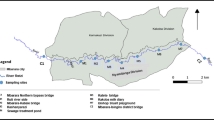Abstract
Heavy metal pollution and their fractionations in the sediments of Changjiang River in Nanjing Reach was monitored for cadmium (Cd), lead (Pb), zinc (Zn), chromium (Cr), and copper (Cu). Moreover, the biological enrichment of metals by riverine plants was studied. The results demonstrated there were highly significant variations among different sampling stations for the concentrations of tested metals. The highest range was for Cu (38.8–120.4 mg kg−1), followed by Cr (74.4–120.0 mg kg−1), Zn (80.9–121.1 mg kg−1), Ni (26.0–55.5 mg kg−1), Pb (15.8–46.7 mg kg−1) and Cd (0.28–0.48 mg kg−1). Cd was the element with highest biological enrichment factor (BEF). The highest BEF of Cd in Erigeron bonariensis reached 3.0, indicating a significant Cd enrichment in this aquatic plant. In addition, 60% of Cd was found in reducible fraction and exchangeable and acid-soluble fraction, which was consistent with its high mobility. The consistency of Cd fraction in sediment and suspended particle indicated they came from the same source. Accumulated Cd concentration calculated according to the release curve showed significant relativity with the total Cd concentration in the sediment.






Similar content being viewed by others
References
Alloway BJ (1995) Heavy metals in soils, 2nd edn. Blackie, Glasgow
Alloway BJ, Thornton I, Smart GA (1988) Metal availability. Sci Total Environ 75:41–69
Cai SM, Du Y, Zeng YH (2002) Main problems of the water and soil environment in middle and lower reaches of Yangtze River and possible countermeasures. Resour Environ 11(6):564–568
Chen SL, Zhang GA, Yang SL, Shi JZ (2006) Temporal variations of fine suspended sediment concentration in the Changjiang River estuary and adjacent coastal waters. J Hydrol 331:137–145
Gaillardet J (2003) Trace elements in river water. In: Drever JI, Holland HD, Turekian KK (eds) Surface and ground water, weathering, and soils. Treatise on geochemistry, vol 5. Elsevier, Oxford, pp 225–272
Hooda PS, Alloway BJ (1998) Cadmium and lead sorption behaviour of selected English and Indian soils. Geoderma 84:121–134
Jain CK, Singhal DC, Sharma MK (2005) Metal pollution assessment of sediment and water in the river Hindon, India. Environ Monit Assess 105:193–207
Kabata-Pendias A, Pendias H (2001) Trace elements in soils and plants. CRC Press, Boca Raton
Kaushik A, Kansal A, Meena S, Kumari S, Kaushik CP (2009) Heavy metal contamination of river Yamuna, Haryana, India: assessment by metal enrichment factor of the sediments. J Hazard Mater 164:265–270
Koshikawa MK, Takejiro T, Takada J, Zhu M, Xu B, Chen Z, Murakami S, Xu K, Watanabe M (2007) Distribution of dissolved and particulate elements in the Yangtze estuary in 1997–2002: Background data before the closure of the three Gorges Dam. Estuar Coast Shelf Sci 71:26–36
Kucuksezgin F, Uluturhan E, Batki H (2008) Distribution of heavy metals in water, particulate matter and sediments of Gediz River (Eastern Aegean). Environ Monit Assess 141:213–225
Lin CY, He MC, Zhou YX, Guo W (2008) Distribution and contamination assessment of heavy metals in sediment of the second Songhua River, China. Environ Monit Assess 137:329–342
Liu L, Li FS, Xiong DQ, Song CY (2006) Heavy metal contamination and their distribution in different size fractions of the surficial sediment of Haihe River, China. Environ Geol 50:431–438
Liu CB, Xu J, Liu CG, Zhang P (2009) Heavy metals in the surface sediments in Lanzhou Reach of Yellow River, China. Bull Environ Contam Toxicol 82:26–30
Platz-Osuna B, Ruizx Fernandez C (1995) Trace metals in the Mexican shrimps, Penaeus Vannamei from estuarine environment. Environ Pollut 87:243–247
Schoellhamer DH, Mumleyc TE, Leatherbarrow JE (2007) Suspended sediment and sediment-associated contaminants in San Francisco Bay. Environ Res 105:119–131
Tessier AP, Campbell GC, Bisson M (1979) Sequential extraction procedure for the speciation of particulate trace metals. Anal Chem 51:844–851
Ure AM, Quevauviller P, Munteau H, Griepink B (1993) Speciation of heavy metals in soils and sediments—an account of the improvement and harmonization of extraction techniques undertaken under the auspices of the BCR of the commission of the European Communities. Int J Environ Anal Chem 51:135–151
Wang ZL, Liu CQ (2003) Distribution and partition behavior of heavy metals between dissolved and acid-soluble fractions along a salinity gradient in the Changjiang Estuary, eastern China. Chem Geol 202:383–396
Woitke P, Wellmitz J, Helm D, Kube P, Lepom P, Litheraty P (2003) Analysis and assessment of heavy metal pollution in suspended solids and sediments of the river Danube. Chemosphere 51:633–642
Xia J (2005) Soil–rock-forming processes and engineering mechanical properties of the ancient gravel stratum near Nanjing. China Eng Geol 78:209–214
Yang SL, Zhao QY, Belkin I (2002) Temporal variation in the sediment load of the Yangtze River and the influence of human activities. J Hydrol 263:56–71
Zhang J (1999) Heavy metal compositions of suspended sediments in the Changjiang (Yangtze River) estuary: significance of riverine transport. Cont Shelf Res 19:1521–1543
Zhou J, Ma DS, Pan JY, Nie WM, Wu K (2008) Application of multivariate statistical approach to identify heavy metal sources in sediment and waters: a case study in Yangzhong, China. Environ Geol 54:373–380
Acknowledgments
This study was partially supported by Natural Science Fund of Jiangsu province (BK2004091), Project of Shaanxi Education Department (07JK187). We are appreciating to Dr. Murray B. McBride for his help in improving the English of our manuscript.
Author information
Authors and Affiliations
Corresponding author
Rights and permissions
About this article
Cite this article
Ma, H., Hua, L. & Ji, J. Speciation and phytoavailability of heavy metals in sediments in Nanjing section of Changjiang River. Environ Earth Sci 64, 185–192 (2011). https://doi.org/10.1007/s12665-010-0837-3
Received:
Accepted:
Published:
Issue Date:
DOI: https://doi.org/10.1007/s12665-010-0837-3




